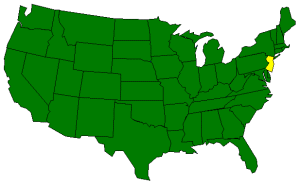
History of New Jersey
Delaware Indians
The first people to live on the land now known as New Jersey were the Delaware Indians. They lived here starting at least 10,000 years ago. Anywhere from 8,000 to 20,000 Delaware Indians lived in the area when the first Europeans arrived. Their name means "original people" or "genuine people." They spoke an Algonquian dialect.
http://www.nj.gov/nj/about/history/short_history.html
Colonial Times
Around 1524, Giovanni de Verrazano became the first European to explore New Jersey. He sailed along the coast and anchored off Sandy Hook. The colonial history of New Jersey started after Henry Hudson sailed through Newark Bay in 1609. Although Hudson was British, he worked for the Netherlands, so he claimed the land for the Dutch. It was called New Netherlands.
http://www.nj.gov/nj/about/history/short_history.html
Battle of Trenton
In November of 1776 the British gained control of New Jersey and forced Washington to flee into Pennsylvania. They thought no one would fight during winter, so the British and Hessian soldiers in New Jersey divided into camps to stay until spring. Trenton was considered the most desirable post, and it went to the Hessian soldiers as a reward for their good service. The Hessians used the Old Barracks in Trenton as a headquarters.
http://www.nj.gov/nj/about/history/short_history.html
Early Statehood

In 1787, New Jersey became the third state to ratify the U.S. Constitution and the first state to sign the Bill of Rights. In 1790, Trenton officially became the state capital of New Jersey. William Livingston became New Jersey's first state governor.
New Jersey grew and prospered during the early 1800s. New factories sprung up throughout the state. Paterson became a textile center and later became known for producing trains and silk. Trenton produced clay products, iron, and steel. Camden, Elizabeth, Jersey City, Newark, and Passaic all became major manufacturing centers in the 1800s.
Industry, Immigrants and Innovation
After the Civil War, the industrial revolution was under way, and New Jersey continued to grow. More factories opened, and cities like Trenton, Newark, Paterson, and Camden got bigger as immigrants from Europe came to work in them. Railroads were laid to connect the cities and to transport materials.
http://www.nj.gov/nj/about/history/short_history.html
The 1900s
Between 1900 and 1930, New Jersey's population more than doubled, and manufacturing became a $4 billion industry. Unfortunately, the Great Depression of the 1930s hit New Jersey hard, bringing massive unemployment. The state rebounded during World War II in the 1940s as New Jersey's electronics and chemical industries began large-scale operations.
http://www.nj.gov/nj/about/history/short_history.html





